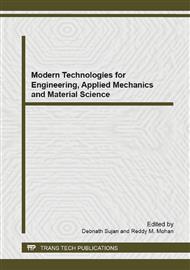[1]
Y. Tian, W. Zuo, D. Chen, Crystallization evolution, microstructure and properties of sewage sludge-based glass-ceramics prepared by microwave heating, Journal of Hazard. Material 196 (2011) 370–379.
DOI: 10.1016/j.jhazmat.2011.09.045
Google Scholar
[2]
H. Wang, C. Wang, F. Chen, M. Ma, Z. Lin, W. Wang, Z. Xu, X. Wang, Modification to degradation of hexazinone in forest soils amended with sewage sludge, Journal of Hazard. Mater. 199–200 (2012) 96–104).
DOI: 10.1016/j.jhazmat.2011.10.073
Google Scholar
[3]
M. Erol , S. Kücükbayrak, A. Ersoy-Mericboyu, Comparison of the properties of glass, glass–ceramic and ceramic materials produced from coal fly ash,. Journal of Hazard. Mater 2008; 153: 418–25.
DOI: 10.1016/j.jhazmat.2007.08.071
Google Scholar
[4]
G. Cultrone E. Sebastián, Fly ash addition in clayey materials to improve the quality of solid bricks,. Journal of Construction and Build Material 2009; 23: 1178–84.
DOI: 10.1016/j.conbuildmat.2008.07.001
Google Scholar
[5]
P.H. Shih, Z.Z. Wu, H.L. Chiang. Characteristics of bricks made from waste steel slag,. Journal of Waste Management 2004; 24: 1043–7.
DOI: 10.1016/j.wasman.2004.08.006
Google Scholar
[6]
C.M.F. Vieira, P.M. Andrade G.S. Maciel, F. Vernilli, S.N. Monteiro. Incorporation of fine steel sludge waste into red ceramic,. Jounal of Material Science Eng A-Struct 2006; 427: 142–7. ).
DOI: 10.1016/j.msea.2006.04.040
Google Scholar
[7]
S.N. Monteiro, J. Alexandre, J.I. Margem, R. Sánchez, C.M.F. Vieira. Incorporation of sludge waste from water treatment plant into red ceramic,. Journal of Constrction and Building Material 2008; 22: 1281–7.
DOI: 10.1016/j.conbuildmat.2007.01.013
Google Scholar
[8]
K.Y. Chiang, P.H. Chou, C.R. Hua K.L. Chien, C. Cheeseman . Lightweight bricks manufactured from water treatment sludge and rice husks,. Journal of Hazard Material 2009; 171: 76-82.
DOI: 10.1016/j.jhazmat.2009.05.144
Google Scholar
[9]
M.A. Montero,M. M Jordán, M.S. Hernández-Crespo, T. Sanfeliu . The use of sewage sludge and marble residues in the manufacture of ceramic tile bodies,. Appllied Clay Science 2009; 46: 404-8.
DOI: 10.1016/j.clay.2009.10.013
Google Scholar
[10]
P. Randal , S. Chattopadhyay . Advances in encapsulation technologies for the management of mercury-contaminated hazardous wastes,. Journal of Hazard Material 2004; B114: 211-23.
Google Scholar
[11]
J.M. Magalhaes, J.E. Silva, F.P. Castro J.A. Labrincha. Effect of experimental variables on the inertization of galvanic sludges in clay-based materials,. Journal of Hazard Material 2004; 106B: 139-47.
Google Scholar
[12]
A. A Abang, S. Chandra . Waste materials used in concrete manufacturing,. New Jersey (USA): Noyes Publications Westwood; (1977).
Google Scholar
[13]
Abdullahi, M. (2005). Compressive Strength of Sandcrete Blocks in Bosso and Shiroro Areas of Minna, Nigeria, AUJT, 9(2), 126-131.
Google Scholar
[14]
Uzoamaka, O. J. (1977a). Some other factors which affects the crushing strength of Sandcrete Blocks,. Materials and Structures, 10(1), 45-48.
Google Scholar
[15]
Afolayan, J. O., Arum, C., and Daramola, C. M. (2008). Characterization of the Compressive Strength of Sandcrete Blocks in Ondo State, Nigeria,. Journal of Civil Engineering Research and Practice, 5 (1): 15-28.
DOI: 10.4314/jcerp.v5i1.29188
Google Scholar
[16]
Wenapere, D.A. and Ephraim, M.E. (2009). Physico- mechanical behaviour of sandcrete block masonry units,. Journal of building.
DOI: 10.1057/jba.2009.8
Google Scholar
[17]
Dhir, J (1980). Civil Engineering material,. Macmillan, London. 5th edition Pp 493-526.
Google Scholar
[18]
ASTM C136, Standard Test Method for Sieve Analysis of Fine and Coarse Aggregates.
Google Scholar
[19]
National Ready Mixed Concrete Association (2003). Concrete in Practice- Testing Compressive Strength of concrete,. Silver spring MD, www. nrmca. org.
Google Scholar
[20]
Van der Sloot, H.A., Dijkstra, J.J. (2004).
Google Scholar


